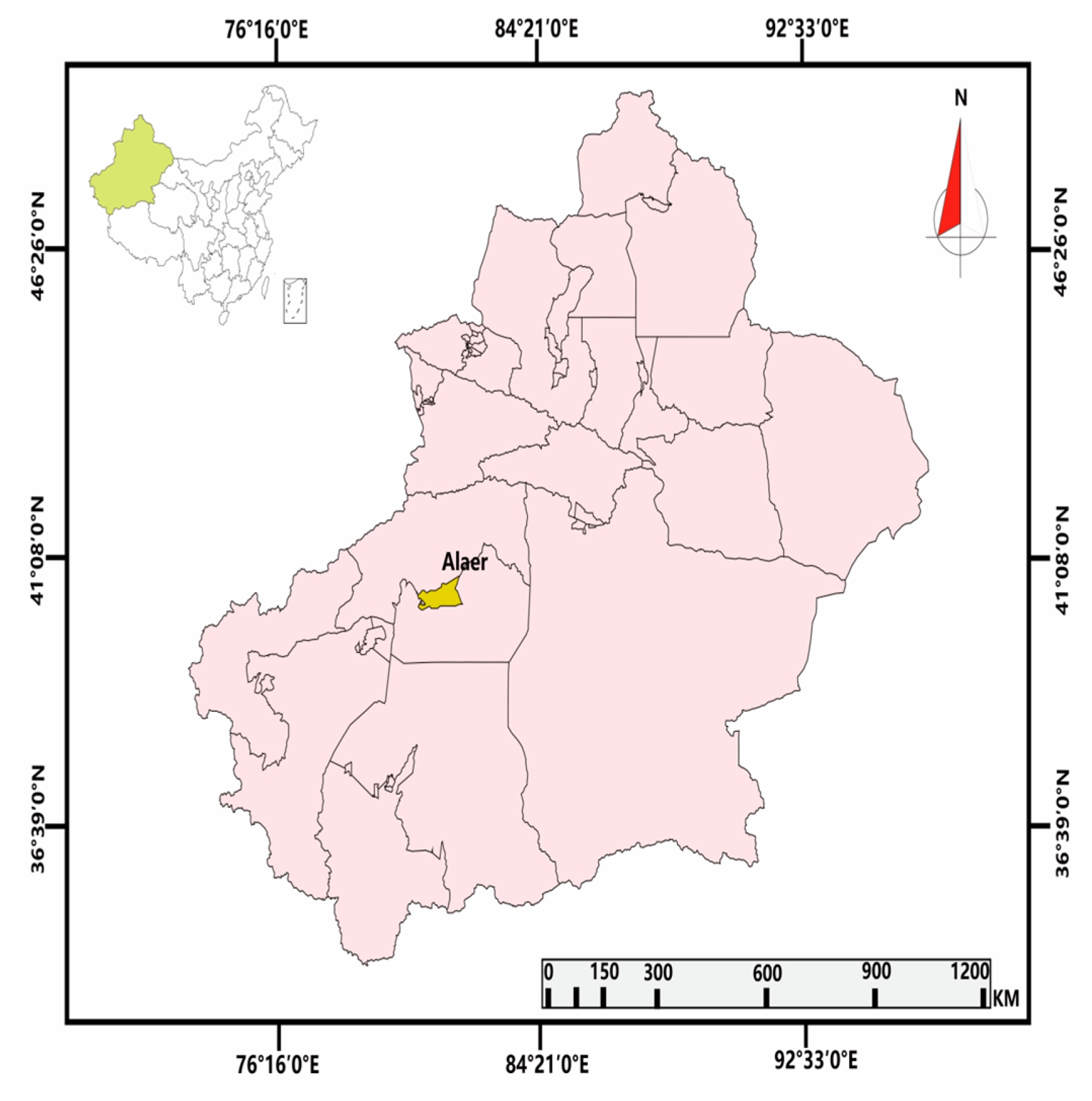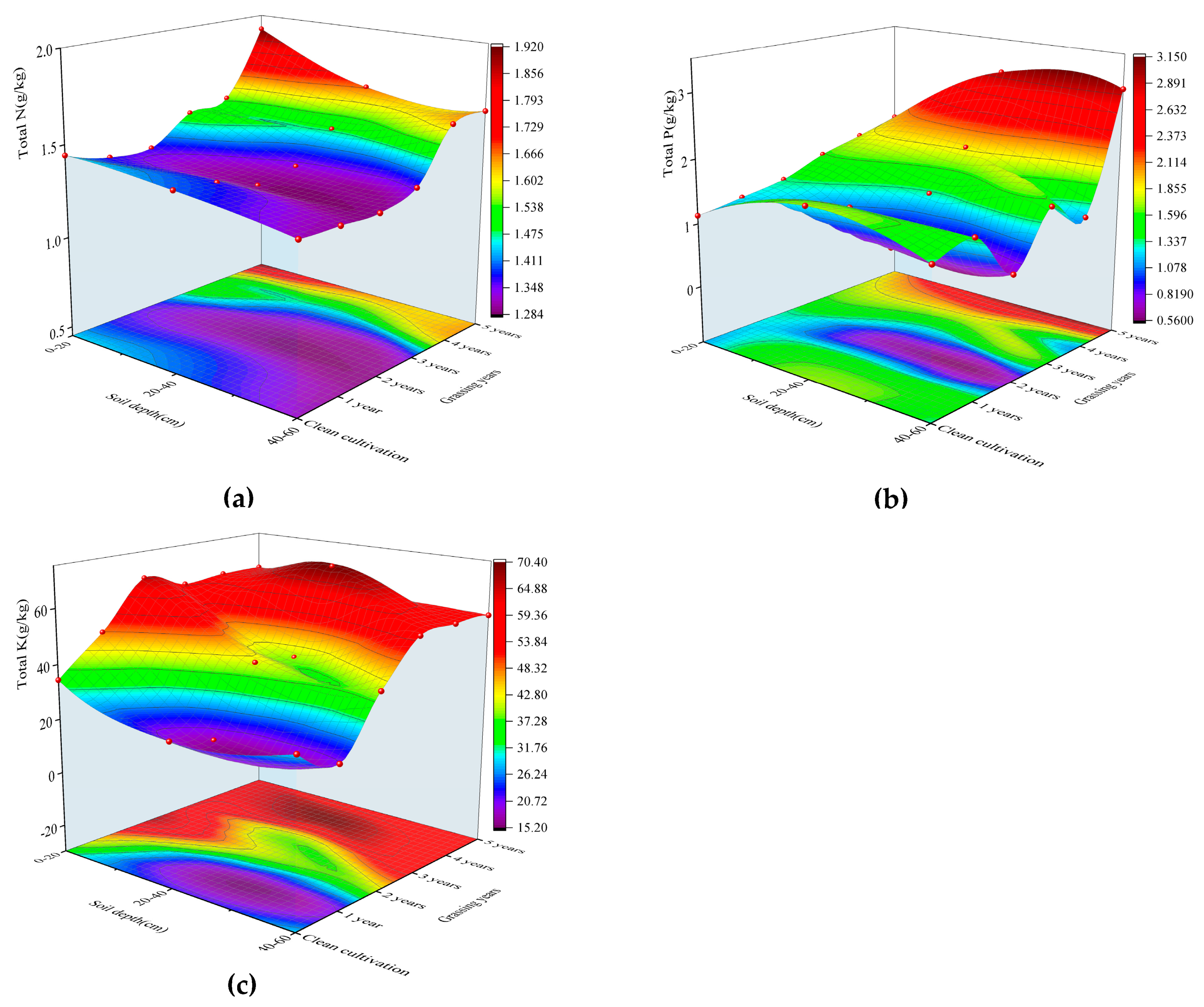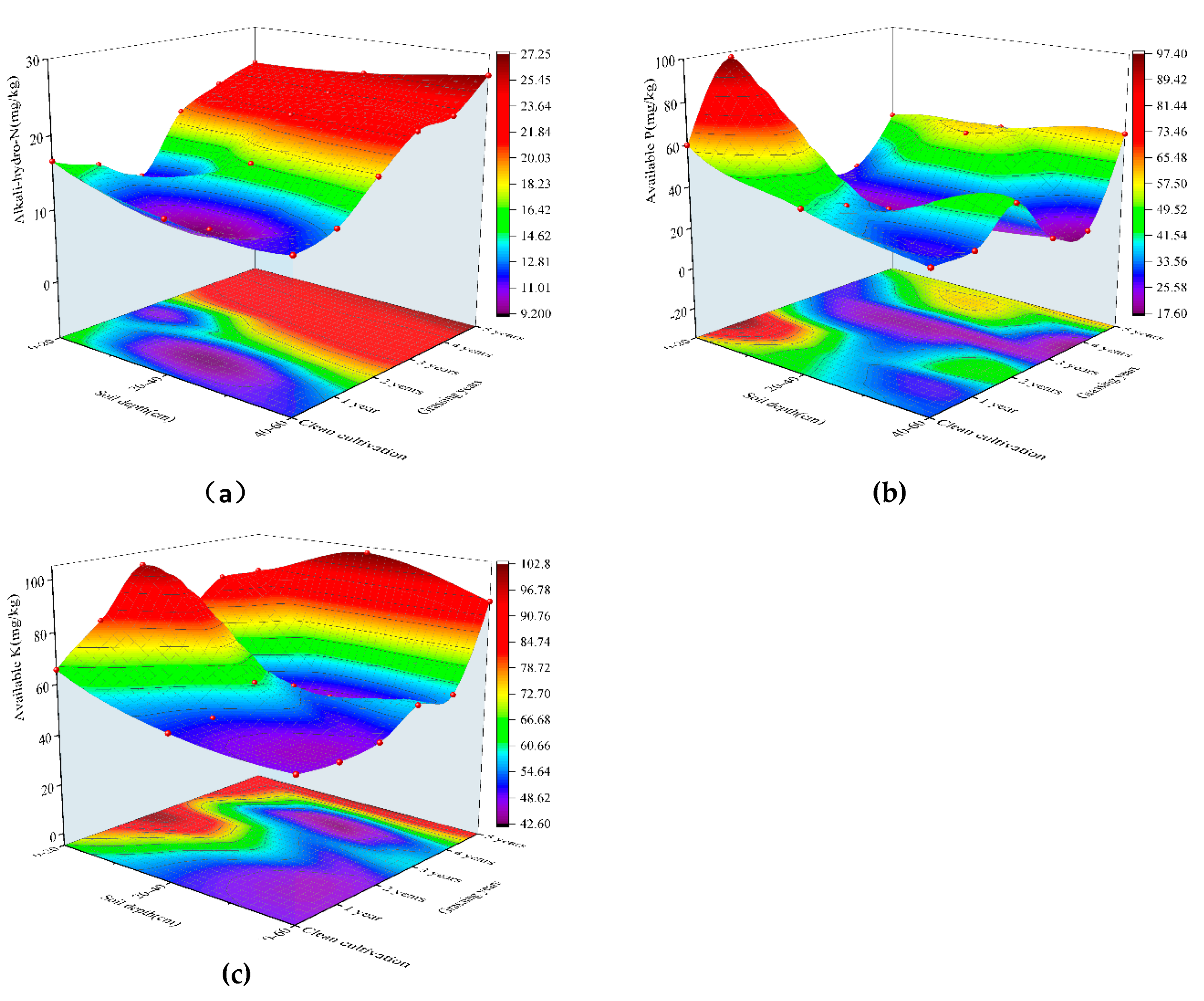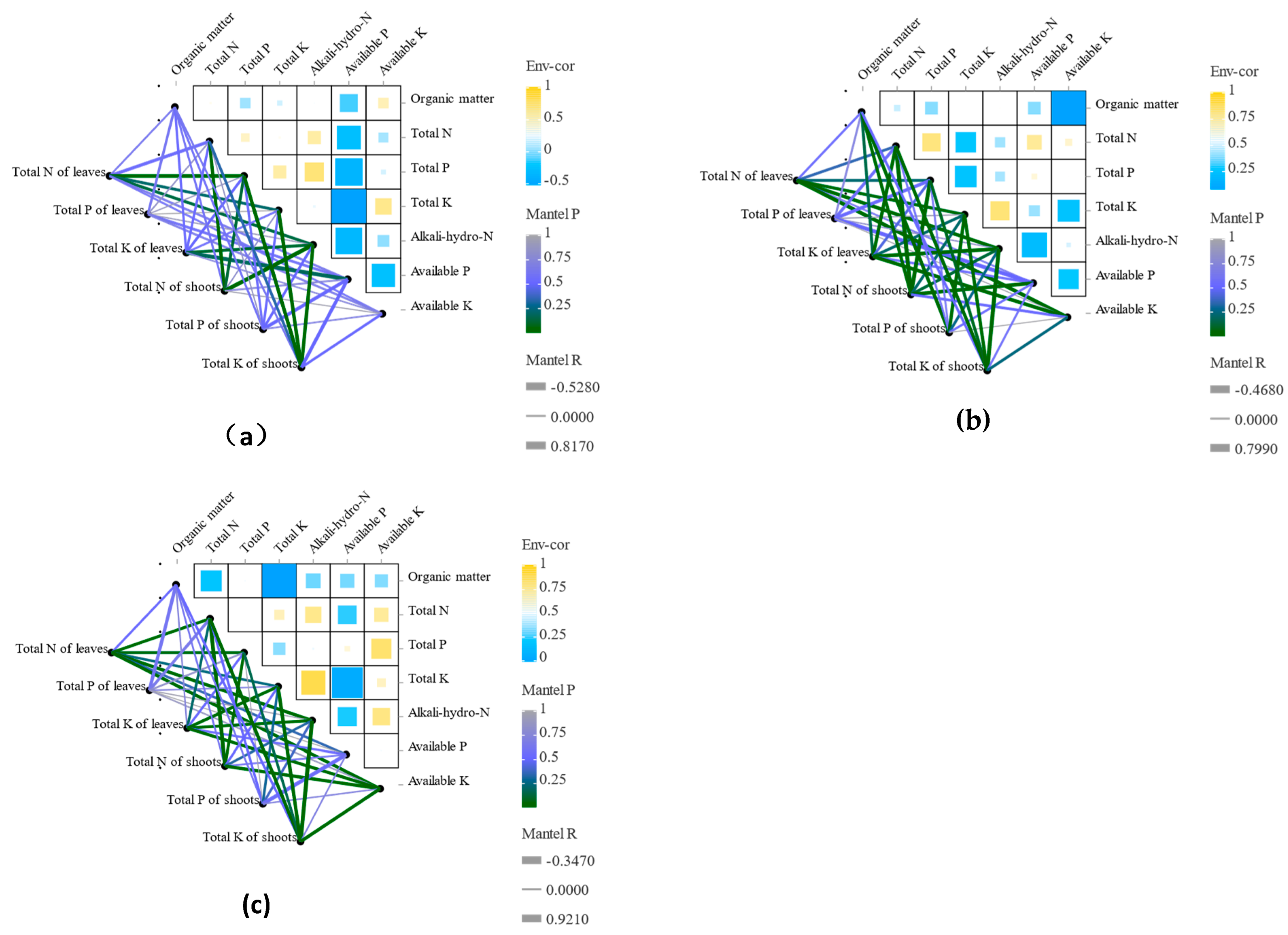Effects of Orchard Grass on Soil Fertility and Nutritional Status of Fruit Trees in Korla Fragrant Pear Orchard
Abstract
1. Introduction
2. Materials and Methods
2.1. Selection of the Test Site
2.2. Sample Collection
2.3. Experimental Design
2.4. Determination Items and Methods
2.5. Data Processing
3. Results
3.1. Effects of Natural Grass Cultivation Years on Soil Nutrient Content in Pear Orchards
3.1.1. Effects of Grassing Years on Soil Organic Matter Content in Pear Orchards
3.1.2. Effects of Natural Grass Cultivation Years on Soil Total Nitrogen, Phosphorus, and Potassium Contents in Pear Orchards
3.1.3. Effects of Natural Grass Cultivation Years on Alkali-Hydrolyzable Nitrogen, Available Phosphorus, and Potassium Content in Soil
3.2. Effect of Natural Grass Cultivation Years on Shoot Nutrient Content of Korla Fragrant Pear
3.3. Effects of Natural Grass Cultivation Years on Leaf Nutrient Content of Korla Fragrant Pear
3.4. Correlation Analysis between Shoot and Leaf Nutrients and Soil Nutrients
4. Discussion
4.1. Effect of Grass on Soil Organic Matter Content in Orchards
4.2. Effect of Orchard Grass on Soil Nutrients in Pear Orchards
4.3. Effect of Grass on Leaf Nutrient Content in Orchard
5. Summary
Author Contributions
Funding
Institutional Review Board Statement
Data Availability Statement
Conflicts of Interest
References
- Chen, J.H.; Ma, J.J.; Li, Y.F.; Lu, X.Y.; Jiang, Y.; Ye, J.J. Effects of intercropping grass on microclimate, photosynthetic characteristics and fruit quality of ‘Korla Fragrant Pear’ orchard. North Hortic. 2019, 22, 49–59. [Google Scholar]
- Li, X.Y.; Ren, L.H.; Ji, B.Q.; Ma, X.T. Effects of grass coverage on soil physical properties in mountain orchards. Appl. Technol. Soil Water Conserv. 2019, 190, 7–9. [Google Scholar]
- Xu, T.W.; Qin, S.J.; Du, G.D.; Lv, D.G. Management measures and research progress after grass planting in orchards in China. Chin. Fruit Trees 2018, 72–75. [Google Scholar]
- Fan, W.X.; Meng, Y.Q.; Chen, G.D.; Guo, Z.X.; Wang, P.J.; Li, T.T.; Li, Y.F. Research progress on the effects of grass mulching cultivation on the physical and chemical properties of orchard soil. Anhui Agric. Bull. 2022, 28, 116–120. [Google Scholar]
- Li, T.T. Effects of Long-Term Different Fertilization on Soil Fertility and Fruit Tree Growth and Development in Apple Orchard under Grass Coverage. Master’s thesis, Northwest University of Agriculture and Forestry, Xianyang, China, 2013. [Google Scholar]
- Bal, L.; Chen, X.; Wang, Z.; Lv, D.G.; Zhao, B. Effects of alfalfa and Elymus sibiricus on soil nitrogen mineralization in apple orchards. Hortic. J. 2015, 42, 2469–2477. [Google Scholar]
- Jiao, R.A.; Zhang, S.H.; Li, Y.; Li, C.Z.; Wang, J.P.; Jiao, J. Research progress on the effect of grass on the growth and development of fruit trees and orchard environment. J. Fruit Trees 2017, 34, 1610–1623. [Google Scholar]
- Jiang, L.L.; Gong, Q.T.; Wu, H.B.; Sheng, F.J.; Sun, R.H. Effects of different grass treatments on soil microbial communities in apple orchards. Appl. Ecol. 2019, 30, 3482–3490. [Google Scholar]
- Huo, Y.; Zhang, J.; Wang, M.C.; Yao, Y.C. Effects of intercropping grass on soil organic matter and mineral elements and their relationships in pear orchard. China Agric. Sci. 2011, 44, 1415–1424. [Google Scholar]
- Wu, Y.S.; Zhang, Y.M.; Ji, X.H.; Zhang, R.; Liu, D.L.; Zhang, Z.Y.; Li, W.Y.; Chen, X.S. Effects of natural grass on soil nutrients, enzyme activities and fruit quality in pear orchards in the Yellow River Delta. Chin. Agric. Sci. 2013, 46, 99–108. [Google Scholar]
- Li, S.W.; Yang, W.Q.; Zhao, R.; Han, M.Y.; Kou, J.C. Effects of intercropping grass on soil fertility in apple orchards. Grassl. J. 2016, 24, 895–900. [Google Scholar]
- Yang, L.; Mao, Y.F.; Hu, Y.L.; Wang, Y.Y.; Zhang, L.L.; Yin, Y.J.; Pang, H.L.; Su, X.F.; Liu, Y.P.; Shen, X. The effect of grass on improving soil fertility and apple tree nutrition in orchards. Plant Nutr. Fertil. J. 2020, 26, 325–337. [Google Scholar]
- Bao, S.D. Soil Agrochemical Analysis, 3rd ed.; China Agriculture Press: Beijing, China, 2000; pp. 30–108. [Google Scholar]
- Wang, Y.; Chen, C.; Lei, Y.S.; Xu, M. Research progress of orchard grass on soil environment and fruit quality related factors. North. Hortic. 2017, 174–179. [Google Scholar]
- Feng, F.; Xie, K.Y.; Abibra, Y.M.M.; Wan, J.C. Effects of orchard grassing on weed control, soil nutrients and fruit tree nutritional status in apple orchard. Xinjiang Agric. Sci. 2023, 60, 982–991. [Google Scholar]
- Wu, T.X.; Sheng, J.; Zhu, P.P.; Guo, Z. Research progress and prospect of ecological effects of grass coverage in orchards. Jiangsu Agric. Sci. 2023, 51, 28–34. [Google Scholar]
- Meng, Z.B.; Liu, H.R.; Long, Z.F.; Zhang, Y. Preliminary study on the effects of intercropping grass on soil characteristics and fruit yield of pitaya orchard. Guizhou Anim. Husb. Vet. 2016, 40, 50–54. [Google Scholar]
- Zuo, Y.H.; Liu, G.Y.; Yang, L.L.; Liang, L.Y.; Tong, Y.A. Effects of planting white clover on soil nutrients and biological properties in persimmon orchard in Weibei, Shaanxi. Appl. Ecol. 2019, 30, 518–524. [Google Scholar]
- Vicente-Vicente, J.L.; Gómez-Muñoz, B.; Hinojosa-Centeno, M.B.; Smith, P.; Garcia-Ruiz, R. Carbon saturation and assessment of soil organic carbon fractions in Mediterranean rainfed olive orchards under plant cover management. Agric. Ecosyst. Environ. 2017, 245, 135–146. [Google Scholar] [CrossRef]
- Liu, J.; Yuan, Q.; Zhang, L.X.; Dai, X.R.; Liu, X.Y.; Ding, R.; Ye, L.N. Soil fertility quality of different artificial shrub land in the northern margin of Kubuqi Desert. J. Northwest For. Coll. 2021, 36, 46–53. [Google Scholar]
- Jannoyer, M.L.; Le Bellec, F.; Lavigne, C.; Achard, R.; Malézieux, E. Choosing cover crops to enhance ecological services in orchards:A multiple criteria and systemic appoach applied totropical areas. Procedia Environ. Sci. 2011, 9, 104–112. [Google Scholar] [CrossRef]
- Wei, Q.Q.; Yang, W.Q.; Han, M.Y.; Mu, X.Q.; Kou, J.C. Effects of white clover returning to apple orchard on soil microbial community. Pratacultural Sci. 2016, 33, 385–392. [Google Scholar]
- Wang, Y.; Chen, C.; Ma, L.N.; Lei, J.; Xu, M.; Lei, Y.S. Effects of intercropping grass on soil nutrients and pH in kiwifruit orchards in the northern foot of Qinling Mountains. China Agric. Bull. 2019, 35, 59–65. [Google Scholar]
- Kou, J.C.; Yang, W.Q.; Cheng, G.T.; Han, M.Y. Effects of different grass species on soil properties in young apple orchards. Agric. Res. Arid. Areas 2012, 30, 145–152. [Google Scholar]
- Yang, Y.; Du, G.D.; Lv, S.S.; Lv, D.G.; Xu, T.W. Effects of grass on soil available nutrient content and tree development in orchards. North. Fruit Trees 2017, 197, 4–8. [Google Scholar]
- Zhao, Z.P. Study on Fertilization Technology of Apple and Kiwifruit Orchard in Shaanxi. Ph.D. Thesis, Northwest University of Agriculture and Forestry, Xianyang, China, 2014. [Google Scholar]
- Neilsen, G.; Forge, T.; Angers, D.; Hogue, E. Suitable orchard floor management strategies in organic apple orchards that augment soil organic matter and maintain tree performance. Plant Soil 2014, 378, 325–335. [Google Scholar] [CrossRef]
- Chen, J.H.; Lu, X.Y.; Li, Y.F.; Ma, J.J.; Jiang, Y.; Ye, J.J. Effects of grass on soil physical and chemical properties in Korla fragrant pear orchard. Heilongjiang Agric. Sci. 2019, 71–79. [Google Scholar]
- Chen, J.; Zhang, Q.; Yang, M.Y.; Yuan, Z.Y. Effects of grass on photosynthetic characteristics and leaf quality of apple in arid desert area. China J. Agric. Sci. Technol. 2021, 23, 160–167. [Google Scholar]
- JiBhat, D.; Sharma, C.L.; Wali, V.K.; Jasrotia, A. Studies on the effect of orchard floorm anagement practices on quality parameters and leaf nutrient status in apricot (Prunus armeniaca L.) cv. New Castle. Progress. Hortic. 2015, 47, 70–73. [Google Scholar] [CrossRef]







| Soil Depth (cm) | Grassing Years | Organic Matter (g/kg) | Total N (g/kg) | Total P (g/kg) | Total K (g/kg) | Alkali-Hydro-N (mg/kg) | Available P (mg/kg) | Available K (mg/kg) |
|---|---|---|---|---|---|---|---|---|
| 0–20 cm | Clean cultivation | 4.13 ± 0.63 aA | 1.44 ± 0.33 bAB | 1.13 ± 0.33 cB | 34.36 ± 3.20 dC | 16.59 ± 1.56 cdBCD | 59.86 ± 2.77 bB | 65.67 ± 5.69 bB |
| 1 year | 3.99 ± 0.32 aA | 1.37 ± 0.22 bB | 1.22 ± 0.27 cB | 48.09 ± 2.30 cB | 14.66 ± 3.17 deCD | 97.44 ± 11.05 aA | 81.00 ± 7.55 abAB | |
| 2 years | 4.20 ± 0.53 aA | 1.37 ± 0.02 bB | 1.34 ± 0.34 bcAB | 65.09 ± 1.39 aA | 11.59 ± 2.69 eD | 48.30 ± 0.38 bBCD | 100.00 ± 9.49 aA | |
| 3 years | 3.72 ± 0.69 aA | 1.51 ± 0.20 bAB | 1.58 ± 0.26 abcAB | 59.94 ± 2.22 bA | 19.56 ± 1.11 bcABC | 30.27 ± 5.52 cCD | 79.33 ± 11.37 abAB | |
| 4 years | 4.31 ± 1.31 aA | 1.55 ± 0.10 bAB | 1.75 ± 0.10 abAB | 61.19 ± 1.47 bA | 22.48 ± 0.98 abAB | 29.11 ± 6.03 cD | 89.33 ± 11.75 aAB | |
| 5 years | 4.65 ± 0.59 aA | 1.92 ± 0.24 aA | 1.93 ± 0.24 aA | 61.19 ± 1.42 bA | 24.68 ± 3.77 aA | 52.35 ± 0.47 bBC | 89.33 ± 4.51 aAB | |
| 20–40 cm | Clean cultivation | 3.02 ± 0.45 bAB | 1.40 ± 0.15 bB | 1.69 ± 0.32 bB | 22.38 ± 1.37 cC | 12.50 ± 2.19 dBC | 42.33 ± 6.22 abcABC | 51.67 ± 3.51 bB |
| 1 year | 2.57 ± 0.59 bB | 1.37 ± 0.06 bB | 1.48 ± 0.59 bBC | 17.84 ± 0.32 cC | 9.32 ± 0.91 dC | 37.72 ± 1.30 bcdABC | 52.33 ± 4.16 bB | |
| 2 years | 2.75 ± 0.30 bB | 1.29 ± 0.03 bB | 0.65 ± 0.23 cC | 41.33 ± 11.95 bBC | 16.49 ± 2.18 cB | 30.21 ± 9.27 cdBC | 61.33 ± 4.51 bB | |
| 3 years | 3.16 ± 0.21 abAB | 1.33 ± 0.04 bB | 1.31 ± 0.08 bcBC | 39.38 ± 7.99 bBC | 21.69 ± 2.06 bA | 20.62 ± 0.43 dC | 55.67 ± 5.86 bB | |
| 4 years | 3.99 ± 0.53 aA | 1.48 ± 0.17 abAB | 1.89 ± 0.58 bB | 69.97 ± 9.17 aA | 23.54 ± 2.00 abA | 57.03 ± 8.85 aA | 46.67 ± 9.71 bB | |
| 5 years | 3.23 ± 0.65 abAB | 1.67 ± 0.12 aA | 2.97 ± 0.01 aA | 54.92 ± 1.06 abAB | 25.29 ± 1.51 aA | 55.56 ± 7.46 abAB | 102.67 ± 9.50 aA | |
| 40–60 cm | Clean cultivation | 2.74 ± 0.16 bA | 1.32 ± 0.06 bB | 1.33 ± 0.16 bBC | 28.99 ± 0.73 cC | 11.94 ± 1.55 dD | 30.64 ± 0.28 bcB | 48.67 ± 2.89 bcB |
| 1 year | 3.50 ± 0.64 abA | 1.31 ± 0.06 bB | 1.48 ± 0.59 bB | 20.63 ± 5.93 dC | 13.31 ± 2.01 dCD | 30.95 ± 2.52 abAB | 47.33 ± 6.03 cB | |
| 2 years | 2.88 ± 0.06 bA | 1.30 ± 0.02 bB | 0.72 ± 0.31 cC | 40.22 ± 4.44 bB | 18.04 ± 2.08 cBC | 45.90 ± 26.32 abAB | 49.00 ± 7.81 bcB | |
| 3 years | 3.23 ± 0.63 abA | 1.36 ± 0.08 bB | 1.52 ± 0.16 bB | 55.06 ± 0.44 aA | 22.32 ± 3.32 bAB | 23.45 ± 4.42 cB | 58.00 ± 4.00 bB | |
| 4 years | 2.95 ± 0.16 abA | 1.63 ± 0.07 aA | 1.16 ± 0.12 bcBC | 55.76 ± 4.61 aA | 23.01 ± 2.19 bAB | 20.62 ± 1.50 cB | 57.33 ± 6.66 bcB | |
| 5 years | 3.68 ± 0.58 aA | 1.64 ± 0.06 aA | 2.97 ± 0.01 aA | 55.48 ± 4.74 aA | 27.21 ± 1.52 aA | 62.13 ± 0.47 aA | 89.67 ± 6.66 aA |
Disclaimer/Publisher’s Note: The statements, opinions and data contained in all publications are solely those of the individual author(s) and contributor(s) and not of MDPI and/or the editor(s). MDPI and/or the editor(s) disclaim responsibility for any injury to people or property resulting from any ideas, methods, instructions or products referred to in the content. |
© 2023 by the authors. Licensee MDPI, Basel, Switzerland. This article is an open access article distributed under the terms and conditions of the Creative Commons Attribution (CC BY) license (https://creativecommons.org/licenses/by/4.0/).
Share and Cite
Wang, Z.; Liu, R.; Fu, L.; Tao, S.; Bao, J. Effects of Orchard Grass on Soil Fertility and Nutritional Status of Fruit Trees in Korla Fragrant Pear Orchard. Horticulturae 2023, 9, 903. https://doi.org/10.3390/horticulturae9080903
Wang Z, Liu R, Fu L, Tao S, Bao J. Effects of Orchard Grass on Soil Fertility and Nutritional Status of Fruit Trees in Korla Fragrant Pear Orchard. Horticulturae. 2023; 9(8):903. https://doi.org/10.3390/horticulturae9080903
Chicago/Turabian StyleWang, Zengheng, Rui Liu, Liang Fu, Shutian Tao, and Jianping Bao. 2023. "Effects of Orchard Grass on Soil Fertility and Nutritional Status of Fruit Trees in Korla Fragrant Pear Orchard" Horticulturae 9, no. 8: 903. https://doi.org/10.3390/horticulturae9080903
APA StyleWang, Z., Liu, R., Fu, L., Tao, S., & Bao, J. (2023). Effects of Orchard Grass on Soil Fertility and Nutritional Status of Fruit Trees in Korla Fragrant Pear Orchard. Horticulturae, 9(8), 903. https://doi.org/10.3390/horticulturae9080903






